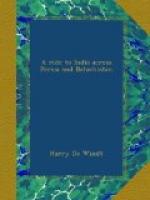Little did I know what was in store for us; for the glass at midday was falling-fast, and at 2 p.m., when we anchored off Lenkoran, it was snowing hard and blowing half a gale.
The western coasts of the Caspian are flat and monotonous. There are two ports of call between Baku and Enzelli—Lenkoran, a dismal-looking fishing-village of mud huts, backed by stunted poplars and a range of low hills; and Astara, the Russo-Persian frontier. Trade did not seem very brisk at either port. We neither landed nor took in cargo at either. A few small boats came out to the ship with fish to sell. The latter is bad and tasteless in the Caspian, with the exception of the sturgeon, which abounds during certain seasons of the year. The fisheries are nearly all leased by Russians, who extract and export the caviar. There is good shooting in the forests around Lenkoran, and tigers are occasionally met with. The large one in the possession of Prince Dondoukoff Korsakoff, mentioned in the first chapter, was shot within a few miles of the place.
We arrived off Astara about 6.30 that evening. It was too dark to see anything of the place, but I had, unfortunately for myself, plenty of opportunities of examining it minutely a couple of days later. We weighed anchor again at nine o’clock, hoping, all being well, to reach Enzelli at daybreak. The sea had now gone down, and things looked more promising.
My spirits rose at the thought of being able to land on the morrow. I was even able to do justice to the abominable food set before us at dinner—greasy sausages and a leathery beefsteak, served on dirty plates and a ragged table-cloth that looked as if it had been used to clean the boiler. But the German Jew had recovered from his temporary indisposition, the cadaverous Persian had disappeared on deck, and the Armenian children had squalled themselves to sleep, so there was something, at least, to be thankful for. Captain Z——, a tall, fair-haired Swede, who spoke English fluently, had been on this line for many years, and told us that for dangerous navigation, violent squalls, and thick fogs the Caspian has no equal. Many vessels are lost yearly and never heard of again. He also told us of a submarine city some miles out of Baku, called by the natives “Tchortorgorod,” or “City of the Devil.” “In calm, sunny weather,” said Z——, “one can distinctly make out the streets and houses.” The German Jew, of a facetious disposition, asked him whether he had not also seen people walking about; but Z—— treated the question with contemptuous silence.
Man is doomed to disappointment. I woke at daylight next morning; to find the Kaspia at anchor, pitching, rolling, and tugging at her moorings as if at any moment the cable might part. Every now and again a sea would crash upon the deck, and the wind, howling through the rigging, sounded like the yelling of a thousand fiends. Hurrying on deck, I learn the worst. A terrific sea is running,




